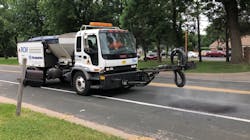For many cities plagued by potholes, it may seem like the repairs never end—and that’s because for many cities using traditional “throw-and-go” repair methods, workers often find themselves fixing the same pothole over and over again.
“They’re truly just throwing asphalt in the hole, and they’re going to the next hole,” said Frank Connelly of RCM Specialties Inc., a dealer of pavement repair equipment. “It’s a very fast process, but there’s no longevity to it.”
Connelly champions another option to resolve cities’ pothole woes: spray patching. Called “the most economical and longest lasting method of pothole repair” by the National Research Council’s Strategic Highway Research Program report, spray patching is a safe, cost-effective technology that offers durable, reliable pothole repair.
How to Repair a Pot Hole with Spray Patching
Truck-mounted models, such as Schwarze Industries’ Roadpatcher, are all-in-one solutions for spray patching. The Roadpatcher utilizes a four-step process to complete pothole repairs. First, a blower uses compressed air to clean debris from the pothole and surrounding cracks. Second, the area is tacked with a hot asphalt emulsion to provide adhesion to the existing pavement. Next, the pothole is filled with a combination of the aggregate mix and the hot asphalt emulsion. Finally, a dry coat is applied.
According to Connelly, using this method with the proper aggregate mix results in a 90 percent or greater compaction rate, without the use of a compactor. “[Operators] don’t have to go and drive over it [and] they don’t have to roll it,” he said. “They can truly do their patch and drive to the next one.”
Truck-mounted spray patchers can be operated by just one worker, helping municipalities save on labor costs when compared with the throw-and-go method, which typically requires a crew of three to five people. The operator is able to stay in the cab of the truck, allowing for safe completion of repairs, even on high-volume roads. Connelly noted that this also helps limit the operator’s exposure to silica dust.
Training is required to familiarize the operator with the spray patching process and controls. According to Connelly, the Roadpatcher is “truly one of the easiest for the operator to get in step with.” Once up to speed with the process, one operator can put down approximately 9 tons of material in a day, he said.
Once a pothole has been repaired using spray patching, it is unlikely the municipality will have to revisit it anytime soon, as the average lifespan of a spray patch repair is five to seven years. The process is effective for shallow or deep pothole repairs, and repairs can be conducted year-round.
Connelly warns against pigeonholing spray patching as just a pothole repair technology, however. Other applications include repairing alligator cracking and cup cracking, priming for chip sealing and more. “You can treat this as a traditional type of an asphalt, to where if you needed to do a utility cut repair, you can do that,” he said. “You can roll it. You can plate it. It’s a very versatile process.”
To learn more about Schwarze’s surface repair solutions, visit http://schwarze.com/en/surface-repair/


